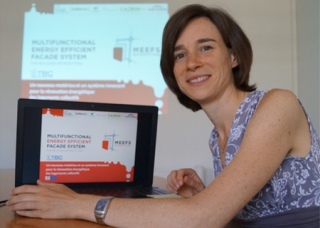Oct 16 2014
To retrofit residential buildings in Europe, there is a growing need for modular solutions that can be applied to the diversity of European climates.
 Photo credit: Christel Jimenez
Photo credit: Christel Jimenez
Retroffiting older buildings has become an industry in its own right in Europe. To compete, various players need to innovate. Now, the EU-funded project MeeFS is developing an innovative multifunctional and energy efficient façade system to retrofit residential buildings. The project is due to be completed by the end of 2015. Christel Jimenez, research and engineering team leader working for one of the project partner organisation, the building innovation consultancy TBC, based in Toulouse, France, tells youris.com about the aims and the remaining challenges for this innovating project.
What are the project’s main advantages compared to existing technologies?
The project covers the façades to retrofit with a set of panels, which can include different technologies. Their advantage is that these panels have modular characteristics. They can either be based on active and passive technologies as well as on traditional or innovative approaches. We developed a methodology enabling us to define the optimal distribution and combination of technologies to realise the highest energy gains, depending on each building’s location, orientation and initial state. This approach allows to take into account potential reservations architects or designers might have, be it related to economic or aesthetic constraints. The project offers them the possibility to play with various materials, textures and colours on the same façade without compromising the energy gains.
What about the price?
The solutions developed by the project are based on a prefab system, with all technologies assembled in the panels before their arrival on-site. We develop a plug-and-play solution, easy to assemble and disassemble for maintenance. This facilitates the on-site work and reduces the installation time and cost. Our target is a seven-year payback time. We can reach this objective if we combine high energy efficiency with a good balance of widespread cost-effective technologies and more expensive innovative ones applicable to most old buildings we are targeting.
What are the remaining challenges and hurdles?
We are entering the demonstration phase of the project. This is a really crucial step to prove the efficiency of our solution in terms of ease of implementation and energy efficiency. We will analyse the measurements of the demonstration building in Merida, Spain, and present the final results at the end of 2015. We want to extrapolate these results to other European locations, as we think the solution we developed has the potential to become a widely used retrofitting technique.
How do you see the adoption across Europe?
We studied the various building typologies across Europe, focusing on old, poorly insulated buildings. From this study results we developed a solution adapted to any kind of existing buildings. We want our retrofitting solution to be as universal as possible.